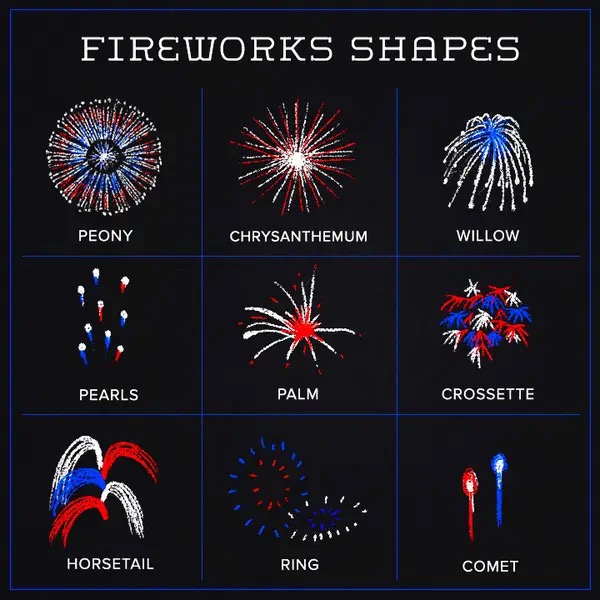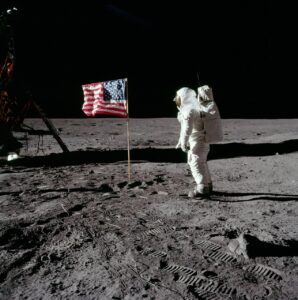Fireworks are known for their amazing visual displays during our nation’s celebration of independence, but there’s a lot to learn about how fireworks got their start, and how they’ve evolved since.

The etymology of the word “firework”
The word “firework” comes from the Greek word “pyrotechnics,” which means, quite appropriately, “fire art” or “fire skill.”
The first fireworks were discovered by accident
Before paper was invented in the second century A.D., scribes in Luyang, China used a stylus to etch ideograms (an ideogram is a written character symbolizing the idea of a thing without indicating the sounds used to say it) on the rounded surface of green bamboo stalks. The ancient scholars utilized this medium for recording transactions and stories. They heated it on coals to dry; if left too long over the heat, air pockets in the bamboo would burst, making a large cracking noise. Thus, accidentally creating the first “firecracker.”
It was found that the noises effectively scared off “abnormally large mountain men;” some historians say the Chinese used fireworks to ward off evil spirits.
The invention of fireworks led to the development of pyrotechnic weapons.
Between 600 and 900 C.E., Chinese alchemists inadvertently mixed saltpeter (potassium nitrate) with sulfur and charcoal, thereby accidentally creating a crude chemical recipe for gunpowder. Apparently, they were searching for an elixir for immortality.
This “fire drug” (or huo yao) played an essential part in Chinese cultural celebrations. Stuffing the bamboo tubes with gunpowder created what is known today as a sparkler. Military engineers soon used the explosive chemical combination as a weapon of war.
The first documented use of weapons utilizing gunpowder in China dates to 1046 and mentions a primitive gunpowder catapult. The Chinese also attached arrows to the bamboo sparklers to rain down on their enemies. The Chinese may have developed the first “biological weapons” by strapping the sparklers on rats to be released into enemy camps.
Although China invented fireworks, Italy invented the aerial shell and colored displays
Today, most public fireworks displays use aerial shells, which look like ice cream cones. The shells, which were developed in the 1830s by Italian pyrotechnicians, contain fuel in a cone bottom, while the “scoop” contains an outer layer of stars, or minute balls containing the chemicals needed to produce the desired color, and an inner explosive charge. Italians are also credited for discovering that metallic powders could be used to create specific colors. The shape that the firework produces is determined by the inner construction of the aerial shell or rocket.
Marco Polo probably did not introduce gunpowder to Europe
Although Marco Polo did return from China in 1295 with fireworks, some historians contend that Europeans were likely exposed to gunpowder during the Crusades. In the 9th century, China began trying to control the flow of gunpowder to its neighbors, in hopes of keeping it out of the hands of potential enemies. Since it is documented that Arabs used various types of gunpowder-like weapons during the Crusades, gunpowder likely spread to the Middle East along the trading route known as the “Silk Road,” despite China’s efforts to limit its spread.
Blue is the hardest color to create in fireworks.
Firework colors are composed of different metal elements. When an element burns, that excites electrons which releases energy in the form of light. When ignited, each chemical produces a specific wavelength of light. Lithium and strontium compounds produce deep reds; copper produces blues; magnesium and titanium emit the colors silver or white; calcium creates orange; sodium burns yellow; and barium produces green. When chlorine is combined with barium or copper, it generates neon green and turquoise, respectively.
Have you ever noticed that the blue fireworks in a pyrotechnic display are not a brilliant blue, rather a pale blue or mauve? As it turns out the color blue is the hardest color to create in a fireworks display.
According to John Conkling, the Technical Director of the American Pyrotechnics Association, “you need the right chemistry.” Copper chloride is used to produce blue light, but it is fragile. The compound needs to reach at least 1,000 degrees Fahrenheit. However, at this point it begins to break down, resulting in a washed-out color.
Some pyrotechnic formulas contain noisemakers
Layers of organic salts, such as sodium salicylate, combined with the oxidizer potassium perchlorate, oxidize one at a time. As each layer burns, a gas is slowly released, creating the whistling sound commonly associated with firework rockets. Aluminum or iron flakes can produce hissing or sparkles, while titanium powder can generate loud blasts, at the same time producing white sparks.
Sparklers are hotter than you think
That innocent-looking sparkler that small children hold in their hands actually burns at a blazing 1,800 to 3,000 degrees Fahrenheit. Three sparklers burning simultaneously generate as much heat as a blowtorch.
The first fireworks in the U.S. were set off by John Smith
John Smith, of Pocohantas fame, in 1608, reportedly used some fireworks, either to impress or scare nearby Native Americans.
Americans have been celebrating Independence Day with fireworks since 1777
According to American University historian James R. Heintze, on July 4, 1777, Philadelphia put together an extravagant day of festivities.
Heintze cites this description from the Virginia Gazette on July 18, 1777:
“The evening was closed with the ringing of bells, and at night there was a grand exhibition of fireworks, which began and concluded with thirteen rockets on the commons, and the city was beautifully illuminated. Everything was conducted with the greatest order and decorum, and the face of joy and gladness was universal. Thus may the 4th of July, that glorious and ever-memorable day, be celebrated throughout America, by the sons of freedom, from age to age till time shall be no more.”










